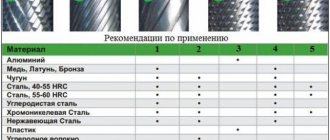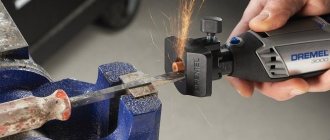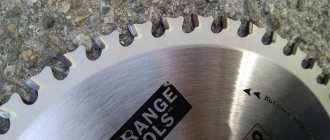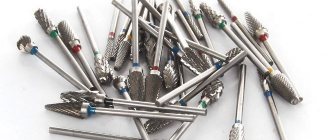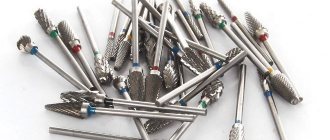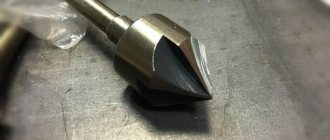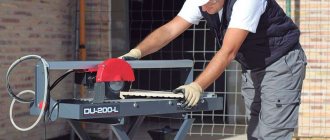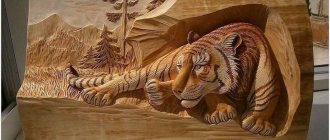Due to the external similarity of the burr with the toothed drill bits of roller bits, the common name metal cutter has firmly been assigned to it. This type of cutting tool has become available to the mass consumer only in recent decades thanks to advances in the production of carbide materials and the widespread use of CNC machining centers in the tool industry. The main purpose of burrs is to mill metals and other materials using hand-held power tools and portable units. And their undeniable advantages are high productivity, low price and minimal requirements for organizing the production process. Metal cutters are used for manual removal of allowances from linear and profile surfaces, processing of holes, grooves, edges and chamfers, cleaning of welds, as well as for turning dies and molds. The name sharoshka not only took root thoroughly, but also received its own development. Nowadays, nozzles made of hard abrasives, the shapes of which are similar to burrs, are even called abrasive cutters in the catalogs of Russian online stores.
Functions and purpose of metal cutters
A metal cutter is a high-speed multi-blade milling tool, mainly intended for rough and preliminary processing of products made of steel, cast iron, non-ferrous metals and their alloys. In industry, such burrs are used mainly for high-speed removal of allowance at the stages of preparation for subsequent finishing processing, including:
- for removing flash and crusts from cast workpieces;
- cleaning and leveling weld seams;
- deburring and chamfering;
- processing of curved surfaces of dies, punches, molds and dies;
- increasing the diameters of holes and window sizes.
In addition to burrs, due to the similarity in appearance, cutters are also called abrasive attachments with cylindrical shanks. Various shapes of metal cutters make it possible to process with sufficient accuracy not only straight, but also profile surfaces, including spherical, parabolic, conical and others. Their main advantage over other types of tools for manual metalworking is the high speed of metal cutting, which for carbide burrs reaches 900 m/min.
Die grinders, hand-held milling cutters, drills and engravers are usually used as drives for cutters. At the same time, the main limitation for the use of cutters for metal is the maximum possible rotation speed of the driven tool. For drills, the spindle speed usually does not exceed 6000 rpm, which is sufficient when using high-speed drills, but does not allow metal to be milled at nominal cutting speeds with small cutters. Engravers using small diameter tools typically use high-speed steel cutters, which can operate at lower cutting speeds.
There is also a tool called a roller cutter, which is neither a burr nor an abrasive attachment. These are the so-called star cutters used for straightening grinding wheels.
What is a roller cutter and where is it used?
A roller cutter (burr, roller bit) is a tool whose history goes back more than a dozen, and perhaps more than one hundred years; there is no exact data on this matter. The design of this tool includes two main elements: a shank, with which the cutter is fixed in the chuck of the equipment used, and a working head, which performs the main work of grinding various materials. During processing, the cutter is given rotation, the speed of which can reach up to 60,000 rpm.
Modern manufacturers produce cutters made of different materials with working heads of various sizes and shapes. This diversity allows you to select a tool to solve specific technological problems. When making such a choice, they are guided primarily by the characteristics of the material from which the product being processed is made, as well as the geometric parameters of the latter.
Metal burrs with extended shank
Cutters for metal and other materials are actively used in many areas, including mechanical engineering, construction, automotive, mining, medicine, jewelry, etc. Using such a tool, you can effectively process products made of various metals, wood, stone, glass, etc. plastic.
You cannot do without cutters when producing plastic windows (with the help of such a tool the joints are cleaned). In the mining industry, it is practiced to use large-diameter stone cutters, the working part of which has carbide teeth installed. In jewelry and in the manufacture of decorative elements, small cutters are used to not only process small parts, but also apply inscriptions and patterns to the surface of products.
Engraving work with a mini cutter on ceramics
Dentistry is another area where cutters are used very actively. It is this kind of tool that is the working part of the well-known drill; it is also used in the manufacture of dentures. In everyday life, cutters installed in the chuck of a conventional electric drill are also used quite often. Using them, home craftsmen solve many problems related to home renovation and maintaining it in proper condition.
Using cutters, correctly selecting their shape and material of manufacture in accordance with the tasks to be solved, you can make a smooth and neat hole in glass, ceramic tiles, stone, brick and wooden products, clean welds efficiently, process hard-to-reach places, something no other tool can handle.
Classification of cutters by material
When processing metals, one of the main production indicators is the cutting speed, on which the main time of the technological operation and, accordingly, the labor intensity of manufacturing the part directly depend. Another important parameter is surface roughness, which, as a rule, is inversely related to cutting speed. The main limitation in achieving the desired values of these indicators is the capabilities of the equipment in terms of rotation speed and the level of spindle runout. For this reason, for different types of processing, cutters of various designs and from different materials are used, among which the most common are:
- hard alloys;
- carbon tool steels;
- high-speed steels;
- hard abrasives;
- diamond coated steel.
In addition, carbide cutters are coated with special materials based on nitrides and carbon to increase wear resistance.
Carbide
The working part of carbide burrs is made of materials with high hardness and refractoriness. Most often these are tungsten and titanium carbides in a cobalt binder with the addition of nickel. Carbide cutters are characterized by the ability to work at high cutting speeds at temperatures in the processing zone up to 1100 °C. Below is a table of the dependence of spindle speeds on diameters and cutting speeds for such carbide tools when working on metal.
To improve the physical characteristics of the cutting edges of the cutters, special coatings are applied to their surfaces, reducing the cutting force and increasing the wear resistance of the tool. Currently, coatings based on titanium nitride are mainly used, each of which, among other things, paints the surface of the roller cutter in a certain color. The most common materials for such coatings:
- titanium nitride (yellow);
- titanium aluminum nitride (blue);
- titanium carbonitride (gray color).
To improve chip control when processing tough metals (aluminum alloys, brass, etc.), cutters with a carbon-based hard coating (LTE), which has a dark gray color, are used.
Made from carbon and high-speed steels
The effective operation of a metal cutter directly depends on compliance with the standard cutting speed. If it is impossible to use drives with the required rotation speed, cutters made of carbon tool and high-speed steels (HSS) are used instead of carbide burrs. In addition, such a tool makes it possible to process metals with lower drive powers. The table below shows the dependence of spindle speeds on cutting speeds and diameters of burrs made of tool and high-speed steels. Recommended cutting speeds for various metals, alloys and plastics can be found in the catalogs of leading burr manufacturers.
It should also be noted that high-speed steel has increased viscosity, and therefore is more resistant to vibration and changes in the hardness of the machined surface during processing. Unlike metals, soft materials are milled at low cutting speeds. In this case, the use of burrs made of tool and high-speed steels is preferable, including for economic reasons.
Diamond
A diamond cutter is no different in shape from carbide burrs, only instead of longitudinal or spiral cutting edges, a thin layer of diamond chips is applied to its surface. This tool is most often used with engravers for fine grinding, engraving and edge processing of products made of hard metals, artificial and natural stone, glass, ceramics, etc. Diamond tools are not designed for removing large allowances, and with intensive work, its coating quickly wears out . Therefore, for the primary processing of the same materials, another type of attachment is used - a bakelite cutter. This grinding tool is much cheaper than a diamond one, has different shapes and is available in different grits.
Abrasive
Abrasive grinding attachments are basically similar in shape to burrs, which is why in everyday life such a tool is called an abrasive cutter. They use ceramic, elastic and bakelite binders as a base, and abrasive fillers, as a rule, are aluminum oxide and silicon carbide. Solid nozzles are used for cleaning castings and welds, removing old coatings, oxides and scale, as well as direct and profile sampling of metal. Bakelite and elastic bits are used for cleaning, rough grinding and precise removal of allowances on metal and other materials. Structurally, such a tool consists of a head in the shape of a cylinder, sphere, cone, drop, etc., which is pressed onto a cylindrical metal shank.
Types of tools and features of their design
Roller cutters are produced in various designs, and for their manufacture, as mentioned above, different materials can be used.
By structure, burrs can be:
- single-cone design;
- double-cone;
- three-cone.
The shapes of the head of such a tool can also be varied. Thus, there are cutters with a conical, cylindrical, spherical, oval or semi-oval head. The choice of one type of tool or another depends both on the nature of the technological tasks and on the geometric parameters of the product to be processed.
Shapes of working heads of cutters
Roller cutters also differ in the material they are made of. Depending on this parameter, these could be:
- tools made of carbon steel;
- diamond cutters, the working part of which is coated with diamond chips;
- abrasive rollers, which can also be sprayed onto the working part or made entirely of abrasive material;
- carbide cutters, on the metal shank of which a working head made of carbide is soldered.
Carbon steel burrs Cutters
made from carbon steel are most often used to work in conjunction with an electric drill or screwdriver. These can be either wood cutters for a drill or a tool designed for processing metal products. One of the main advantages of such a burr is its low price.
Carbon steel cutter teeth wear heavily when working with hard metals
Using this metal tool, even at home, you can process recesses of complex configurations, eliminate sharp edges on products, create smooth and neat holes and increase the diameter of existing ones.
Diamond coated cutters
Diamond cutters, which can also be used in conjunction with hand-held power tools, are already a professional tool. It can be used for fine grinding and boring of holes. Such tools demonstrate their effectiveness not only when processing fragile materials such as glass or ceramics, but also when working with high-strength materials where metal cutters are simply powerless.
Professional diamond-coated bits
A diamond cutter is exactly the tool that is equipped with engraving machines, which allow processing the smallest details and applying various patterns and inscriptions to the surface of products. The surface processed using a diamond cutter has a minimal degree of roughness.
Abrasive cutters
From the point of view of application, an abrasive cutter made by spraying is not much different from a diamond-type tool. Due to the high hardness of its working part, the abrasive cutter can be successfully used for processing materials such as metal, plastic, ceramics and glass, concrete, artificial and natural stone, brick, etc. Like the tools of the two previous categories, the abrasive cutter can be used in any shapes and sizes, and can also be used in conjunction with a drill and screwdriver.
Corundum cutters
The working part with which the abrasive cutter is equipped is made by spraying or made entirely of abrasive material, which is most often used electrocorundum. An abrasive roller bit has a low cost, but also lasts significantly less than even a metal tool.
Carbide head cutters
Roller cutters, the working part of which is made of hard alloy, are used primarily in industrial conditions. Carbide cutters, which are equipped with powerful and high-speed power tools, are used for processing materials of high hardness - cast iron, heat-resistant and stainless steel, titanium alloys, etc.
Metal cutters with carbide head
Cones of this particular type are the optimal choice in cases where it is necessary to qualitatively process welded seams. Carbide tools, the working part of which can also have different configurations, are characterized by an exceptionally long service life.
Types of rollers by shape
Burrs are available with various shapes of cutting surfaces, since they are intended not only for linear processing, but also for profile cutting of grooves, ledges, recesses and edges. The main shapes of the heads of this tool are regulated by Russian GOST 3402-2017, which corresponds to international ISO standards and German DIN. Among them, the most common are cylindrical, spherical and conical (in various variations). The table below shows the basic shapes and letter codes of burrs for processing metal and soft materials, as well as the types of profiles for which they are intended.
In addition to the shape of the cutting head, the burr is characterized by geometric dimensions, length and diameter of the shank, as well as the type of cutting teeth, which also has a standardized designation (see the next section).
Tips for processing various materials
When choosing the right burr for processing metals, plastics or other soft materials, the most important criterion is the configuration of the cutting teeth.
Not only the cutting speed and surface roughness depend on this, but also the ability to quickly remove chips from the work area. The latter is very important when processing ductile metals, whose chips, if the wrong tool is selected, clog the grooves between the cutting teeth. This in turn reduces productivity and causes overheating of the burr. This is why the aluminum cutter has such a large space between the cutting surfaces and such deep grooves (see type N in the figure below). Types of cutting surfaces are also standardized and have a letter designation, which is usually indicated last in the code of a particular product. The figure below shows basic tooth configurations, and the table provides recommendations for their use when processing various metals, alloys, plastics and reinforced materials.
| № | Material | D | S | N | C.B. | DC |
| 1 | Aluminum and its alloys | — | — | * | — | — |
| 2 | Copper, bronze, brass | * | — | — | * | — |
| 3 | Zinc alloys | — | — | * | — | — |
| 4 | Titanium alloys | * | * | — | * | * |
| 5 | High hardness steel | * | * | — | * | — |
| 6 | Structural steel | * | * | — | * | * |
| 7 | Alloy steel | * | * | — | * | — |
| 8 | Stainless steel | * | * | — | * | — |
| 9 | Cast iron | * | * | — | * | — |
| 10 | Welds | * | * | — | * | — |
| 11 | Carbon fiber | — | * | — | — | — |
| 12 | Fiberglass | — | — | — | — | * |
| 13 | Plastics | — | — | * | * | * |
In addition to instructions for choosing a tooth configuration, in the catalogs of burr manufacturers you can always find tables with the values of cutting speeds and rotational speeds for specific types of metals and other materials.
What to look for when choosing a cutter
When choosing a cutter, you first need to figure out what metal (or other material) it is intended for processing.
To some extent, the rule can help here: the higher the hardness of the material being processed, the finer the notch. But not always. In addition, you need to have a good idea of which surfaces of which metals are to be processed and whether the chosen shape of the cutter is suitable for these purposes. All of these are very important characteristics, so it is best not to do it yourself, but to use tables from manufacturers’ catalogs, similar to those given above. Another limiting factor in choosing the right cutter is the rotation speed of your power tool. If this is an electric drill, then a cutter made of hard alloys when milling metals will not be able to operate at the specified cutting conditions, so purchasing it is not economically profitable. The best option for a cutter for a drill for metal processing is a tool made of high-speed steel. Also important parameters of any burr are the diameter and length of the shank. The mass of the metal of the shank dampens possible vibration, so whenever possible you need to choose the maximum available diameter. Length, on the contrary, is a factor contributing to vibration, which is especially noticeable on metal with an uneven structure. Therefore, it must correspond exactly to the intended types of processing.
The cost of the most common types of carbide cutters made in China is no more than 500 rubles. How efficient and durable is such a tool when used for milling hard steel or stainless steel? If anyone has experience using these burrs, please share your opinion about them in the comments to this article.
How to use burrs correctly
A few decades ago, cutters were used only for processing in combination with hand tools. The development of new materials and the development of technologies have led to manufacturers changing their attitude towards burrs and beginning to use them to equip stationary machines, including those with CNC systems.
Despite the fact that processing using cutters mounted on hand-held power tools is highly effective, it does not create perfectly smooth surfaces. In addition, use in conjunction with hand tools negatively affects the condition of the cutters themselves, whose cutting edges become jagged, which, accordingly, reduces their service life.
The size of the working attachment must correspond to the tool used
Installing cutters on CNC machines allows not only to increase the service life of the tool, but also to significantly improve the quality and accuracy of the processing performed. In particular, when using such equipment, it is possible to accurately maintain such processing parameters as the thickness of the layer of metal being removed, the angle of inclination and depth of the grooves created on the surface of the part, the depth and diameter of the hole being made or bored.
However, if you follow certain rules for processing with cutters using hand-held power tools, you can not only extend the service life of the burr itself, but also minimize its negative impact on the equipment with which it is used.
Let us present these rules.
- The working part of the cutter must be in full contact with the surface being processed, which will improve the quality of the technological operation and its efficiency. In addition, it is necessary to ensure that the metal shank of the tool does not come into contact with the surface of the workpiece, as this can lead to destruction of the junction of the working head and the shank.
- During processing, strong mechanical pressure should not be applied to the cutter. If this requirement is neglected, it may reduce the efficiency of the processing performed and increase the load on the power tool, which will lead to its overheating and, as a result, rapid failure.
- It is very important to choose the right processing speed. This will not only increase the service life of the drill you are using, but will also reduce energy costs. It should be borne in mind that processing using a cutter rotating at high speed allows you to avoid many problematic situations, which, in particular, include the formation of irregularities and burrs on the surface of the workpiece, and jamming of the tool in the material being processed. In addition, using a tool rotating at high speed, corners and grooves can be processed more carefully and accurately.
- The working head of a roller cutter, like any other tool in contact with hard materials, is subject to active wear and abrasion. There are several simple techniques that can reduce the wear rate of the cutter head and extend the service life of the tool. One of these techniques involves the use of a special lubricant, which is periodically applied to the working head of the burr. Lubrication reduces the load on the tool and allows it to glide better over the surface of the workpiece. Another method is that during the processing process the working head of the cutter is immersed from time to time in a special suspension, the basis of which can be wax or synthetic machine oil.
- If you notice that the tool is very worn, immediately replace it with a new one. Using a heavily worn tool to perform processing will not only require significant physical effort, but can also lead to damage to the cutter itself and/or the power tool.

